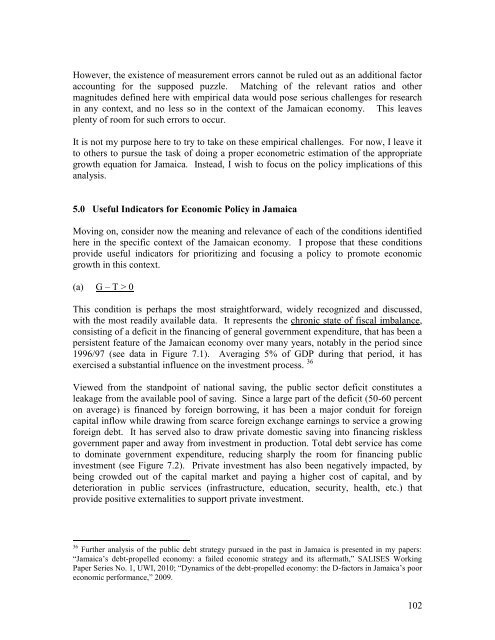PIOJ Growth-Inducement Strategy - Planning Institute of Jamaica
PIOJ Growth-Inducement Strategy - Planning Institute of Jamaica
PIOJ Growth-Inducement Strategy - Planning Institute of Jamaica
You also want an ePaper? Increase the reach of your titles
YUMPU automatically turns print PDFs into web optimized ePapers that Google loves.
However, the existence <strong>of</strong> measurement errors cannot be ruled out as an additional factor<br />
accounting for the supposed puzzle. Matching <strong>of</strong> the relevant ratios and other<br />
magnitudes defined here with empirical data would pose serious challenges for research<br />
in any context, and no less so in the context <strong>of</strong> the <strong>Jamaica</strong>n economy. This leaves<br />
plenty <strong>of</strong> room for such errors to occur.<br />
It is not my purpose here to try to take on these empirical challenges. For now, I leave it<br />
to others to pursue the task <strong>of</strong> doing a proper econometric estimation <strong>of</strong> the appropriate<br />
growth equation for <strong>Jamaica</strong>. Instead, I wish to focus on the policy implications <strong>of</strong> this<br />
analysis.<br />
5.0 Useful Indicators for Economic Policy in <strong>Jamaica</strong><br />
Moving on, consider now the meaning and relevance <strong>of</strong> each <strong>of</strong> the conditions identified<br />
here in the specific context <strong>of</strong> the <strong>Jamaica</strong>n economy. I propose that these conditions<br />
provide useful indicators for prioritizing and focusing a policy to promote economic<br />
growth in this context.<br />
(a) G – T > 0<br />
This condition is perhaps the most straightforward, widely recognized and discussed,<br />
with the most readily available data. It represents the chronic state <strong>of</strong> fiscal imbalance,<br />
consisting <strong>of</strong> a deficit in the financing <strong>of</strong> general government expenditure, that has been a<br />
persistent feature <strong>of</strong> the <strong>Jamaica</strong>n economy over many years, notably in the period since<br />
1996/97 (see data in Figure 7.1). Averaging 5% <strong>of</strong> GDP during that period, it has<br />
exercised a substantial influence on the investment process. 36<br />
Viewed from the standpoint <strong>of</strong> national saving, the public sector deficit constitutes a<br />
leakage from the available pool <strong>of</strong> saving. Since a large part <strong>of</strong> the deficit (50-60 percent<br />
on average) is financed by foreign borrowing, it has been a major conduit for foreign<br />
capital inflow while drawing from scarce foreign exchange earnings to service a growing<br />
foreign debt. It has served also to draw private domestic saving into financing riskless<br />
government paper and away from investment in production. Total debt service has come<br />
to dominate government expenditure, reducing sharply the room for financing public<br />
investment (see Figure 7.2). Private investment has also been negatively impacted, by<br />
being crowded out <strong>of</strong> the capital market and paying a higher cost <strong>of</strong> capital, and by<br />
deterioration in public services (infrastructure, education, security, health, etc.) that<br />
provide positive externalities to support private investment.<br />
36 Further analysis <strong>of</strong> the public debt strategy pursued in the past in <strong>Jamaica</strong> is presented in my papers:<br />
“<strong>Jamaica</strong>’s debt-propelled economy: a failed economic strategy and its aftermath,” SALISES Working<br />
Paper Series No. 1, UWI, 2010; “Dynamics <strong>of</strong> the debt-propelled economy: the D-factors in <strong>Jamaica</strong>’s poor<br />
economic performance,” 2009.<br />
102
















